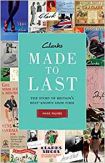Made to last: The story of Britain's best-known shoe firm by Mark Palmer
| Made to last: The story of Britain's best-known shoe firm by Mark Palmer | |
|
| |
| Category: Business and Finance | |
| Reviewer: John Van der Kiste | |
| Summary: An account of Britain's best-known shoe firm, from its origins as a sheepskin rug-making business almost two centuries ago. | |
| Buy? Yes | Borrow? Yes |
| Pages: 398 | Date: April 2013 |
| Publisher: Profile | |
| ISBN: 9781846685200 | |
|
| |
From its founding by the Quaker brothers Cyrus and James Clark in the Somerset village of Street, to its present-day status as a global shoe brand, the name of Clark has weathered many a storm as it draws close to its bicentenary. This account of the company, by a distant kinsman of the two original founders, has drawn heavily on the archives and on in-depth interviews with the family to tell the full story.
In 1825 the Clarks went into business, making sheepskin rugs and slippers. Cyrus, the elder, had already had some experience in fellmongering, the removal of sheep’s wool from hides in preparation for tanning, and woolstapling, the buying of wool, grading and then selling to a manufacturer. James became his apprentice, and the business arrangement was drawn up eight years later. For many years they manufactured shoes in Somerset, building several factories in the area and later throughout the south-west. With their Quaker ethos, they provided for workers’ housing, education and leisure activities, as well as keeping Street dry for several generations. Despite industrial troubles and economic recessions it continued to thrive, although it was not immune to the problems faced by so many similar organisations. With ever-rising costs and low productivity it eventually moved production abroad, mainly to India, Brazil, Cambodia, China, and Vietnam.
Even in the nineteenth century, workforce and management were sometimes at odds. The company had its first strike, albeit a shortlived one, in 1867 when machine operators briefly downed tools in pursuit of higher pay. Another, lasting almost two weeks, occurred when a new foreman hired by the company, not over-blessed with tact, tried to impose new methods and machinery, and hire boys as they were cheaper than men. He was quietly eased out once the stoppage ceased.
By the end of the century Clarks was thriving, with total sales of shoes having reached £140,000, of which 60% was accounted for by the home market. However in the post-World War One depression it was a different story. By 1926 the machine room at the main factory was so quiet that the company had to accept an order for 5,000 pairs of gaiters, described as ‘rather in the spirit of a manufacturer of aeroplanes agreeing to make scooters.’
Further mall but significant changes as it adapted to the modern world were the registering of the single word Clarks without an apostrophe as a trademark in the late 1920s and the first national advertising campaign in 1933, in the form of 140 posters for the London Underground designed by the artist Edward McKnight Kauffer. It was one of the few businesses to have what the author calls ‘a good war’ between 1939 and 1945. As it was designated a ‘nucleus firm’ by the Board of Trade, the workforce were unlikely to be called up, and the company had government contracts, which included providing footwear to the Auxiliary Territorial Service and the RAF.
The company went from strength to strength at the dawn of the 1960s, with factories running at full capacity at the start of the decade while retailers were complaining of a lack of stock. However the boom could not last. Within a few years, largely as a result of the rising cost of raw materials, some factories were closed altogether and workers were laid off at others. As the economic crisis worsened in the 1970s, the company shared in the nation’s general woes with imports of cheap shoes flooding into the country, sales of home-produced footwear falling further, and more redundancies as a result. By 1990 one-third of Clarks shoes were made abroad, mainly in Europe, the United States and the Far East, which became the shape of things to come. In 2006 the last pair of British-made Clarks shoes were produced at the Millom factory in Cumbria, which closed that August.
So how British is the brand name of Clarks these days? We can take some consolation, as the author shows us, of reading how fashions which originated with the company over the years. Perhaps its greatest success was the Desert Boot, a particular favourite of Sarah Jessica Parker, Bob Dulan and Liam Gallagher of Oasis (who collaborated with the company to design his own version as part of his own clothing label – nothing like having something in reserve should the day job prove too onerous). Tony Blair likewise wore a pair in 1999 while promoting his Cool Britannia campaign.
So all in all, this is an interesting story of the origins, rise and not-quite-fall of an iconic national brand. While Clarks has been unable to turn back the tide of so many negative factors which have capsized many another household name business over the last few years, we are left on the last page with the concluding thought that this is ‘a redoubtable British institution striding purposefully towards its 200th anniversary’. Two sections of colour plates, consisting largely of some of the more striking adverts, black and white pictures integrated with the text throughout, a four-page chronology and a family tree add to the value of this book as a work of reference.
For a look at another household nam we can recommend Onward: How Starbucks Fought For Its Life Without Losing Its Soul by Howard Schultz and Joanne Gordon
Please share on: ![]() Facebook,
Facebook, ![]() Twitter and
Twitter and
![]() Instagram
Instagram
![]() You can read more book reviews or buy Made to last: The story of Britain's best-known shoe firm by Mark Palmer at Amazon.co.uk Amazon currently charges £2.99 for standard delivery for orders under £20, over which delivery is free.
You can read more book reviews or buy Made to last: The story of Britain's best-known shoe firm by Mark Palmer at Amazon.co.uk Amazon currently charges £2.99 for standard delivery for orders under £20, over which delivery is free.
![]() You can read more book reviews or buy Made to last: The story of Britain's best-known shoe firm by Mark Palmer at Amazon.com.
You can read more book reviews or buy Made to last: The story of Britain's best-known shoe firm by Mark Palmer at Amazon.com.
Comments
Like to comment on this review?
Just send us an email and we'll put the best up on the site.


